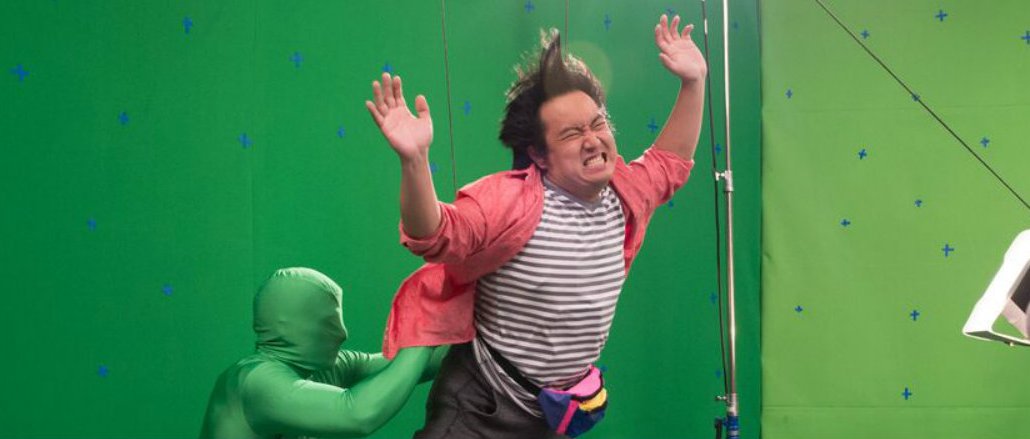Join us Dec. 1-3 in New Orleans for the Digiday Programmatic Marketing Summit
‘The economics don’t make sense’: Freddie Wong on why it’s easier to make shows for Hulu than YouTube

Freddie Wong is a pretty big name on YouTube. His RocketJump channel, which he co-founded in 2006, has more than 7.6 million subscribers and 1.2 billion lifetime views.
Wong has built a devout following who love his style of action- and SFX-heavy comedy shorts. He’s also done something that many of his colleagues have yet to even try — make a successful TV show on YouTube. His show “Video Game High School,” which ran for three seasons, has more than 110 million views on YouTube. And a lot of those views happened on episodes that ran for 30-40 minutes.
Now, Wong has partnered with Lionsgate and Hulu for another long-form series called “RocketJump: The Series,” which will document his team at RocketJump as they produce their trademark short films. Spanning eight half-hour episodes, the series will debut on Hulu in December. Digiday sat down with Wong to talk about the new show and the challenges in doing high-end content for YouTube.
Here are excerpts from the interview, which have been lightly edited for clarity.
Why do a show like this for Hulu?
We felt the itch to keep doing shorts, but also find some new directors to work with, give some new talent an opportunity to try and do a short film — a real, honest-to-god short film that has real production value behind it where it’s not just your typical film-school short.
Which, judging from the trailer involves wrecking school buses …
Yeah, just destroying stuff and having a good time. There are not a lot of opportunities to try that stuff out, especially for young directors. So, how can we make shorts with an actual budget that doesn’t need to be tied to a brand deal.
When did Hulu get involved?
Early on. After “VGHS” season three, we started going around talking to people and Hulu was the first place where it was very clear that they understood what the needs of content were. We said to them we wanted to do the show this way and this is the budget and they said good, OK, and that was it. There is a marked difference from that conversation compared to any other conversation we were having, which were for the most part, “Oh, great, how much are you going to crowdfund?” Or, “Fine, but you’re going to need X number of minutes of content.” There were always caveats. Hulu let us go out far into left field. W
The show’s coming out in December. There’s some talk about the distribution including YouTube, where you release the shorts after the full episode runs on Hulu.
We’re still trying to figure out exactly what that will be. Our philosophy is try not to piss people off.
When you say try not to piss people off, do you mean your fans?
It’s everything. It’s fans, it’s potential future fans. One of the things we found with “VGHS” that was interesting was, once we got to Netflix, iTunes, Xbox, PSN, a totally different crowd showed up. A crowd that in some cases had never heard of us on YouTube. It blew my mind. I always thought it was going to be a subset of our YouTube audience. It’s really opened our eyes in terms of consumption behavior. People are going to find things where they’re going to find them. So we’re very excited about finding out what that audience looks like across different platforms.
How receptive has Hulu been in this process?
A lot of times people today are like, “Hey, let’s take this Internet thing with a lot of fans and let’s plug X into Y and hope that it works.” But to me that’s completely missing the point of why X got popular in the first place. What about X is interesting? And Hulu understands that.
You have a theory about the different tiers of content and their relative ability to succeed on YouTube.
There is no hierarchy implied here, but I like to think of YouTube in three tiers.
Tier one is user-generated content. Stuff that comes off cell phones and is captured without any additional production value. That’s the stuff that generally tends to go viral, too. Tier two has a little more production thought behind it. It was maybe created with the purpose of creating something for the Web. Tier three is professionally produced content: Music videos, movie trailers, bits from “The Tonight Show,” these are also things that were not made for YouTube.
Over the course of the first five years on YouTube, everything was only tier one and tier two.
Why is that?
One of the the difficulties of doing television-style content on YouTube is that the economics don’t make sense. It’s very hard to pay for it. We definitely noticed for the type of content we want to focus on, which is long-form, television- and feature-length stuff, that’s harder to do on YouTube. Not that you can’t do it, it’s just harder.
You were able to.
It wasn’t like we had an idea and then made the thing. No, we were a top-level YouTube channel that had to do a lot of crowdfunding and then still had to find sponsors in order to get everything paid for.
Any interest in doing a TV show for a linear network?
Yeah, absolutely. We grew up in the era of Blockbuster. We always want to do shorts, but the focus for us at RocketJump is how do we make five kick-ass movies and shows a year. That’s where we want to get to.
More in Media

Forbes launches dynamic AI paywall as it ramps up post-search commercial diversification plans
For the latest Inside the publisher C-Suite series, Digiday spoke to Forbes CEO Sherry Phillips on its AI-era playbook, starting with its AI-powered dynamic paywall to new creator-led commercial opportunities.

Creators embrace Beehiiv’s push beyond newsletters
Creators are embracing Beehiiv’s new website, product and analytics tools to help them grow beyond the competitive newsletter space.

Media Briefing: Publishers turn to paid audience acquisition tactics to tackle traffic losses
Publishers facing declining organic traffic are buying audiences through paid ads and traffic arbitrage, and using AI tools to do it.





